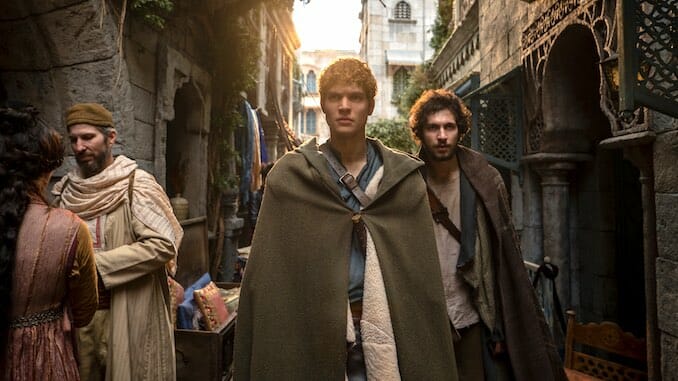Is The Wheel of Time Getting Lost in Translation?
Photo Courtesy of Amazon Prime Video
Adapting The Wheel of Time to the screen was always going to be an uphill battle. Robert Jordan’s sweeping fantasy series (completed by Brandon Sanderson after Jordan’s death) ran 14 books, plus a prequel novel, each one hundreds of pages. With a sprawling cast, intricate rules for magic and a detailed world, it does not lend itself well to the screen. But Amazon has filmed it. So far though, the show’s caution in diving into the greater mythos and world of the series is leaving it feeling indistinct.
It’s a difficult challenge. The show wants to set up its characters first, since without internal thoughts that emotional attachment is harder to create. But it also has to thread the needle of being true to the books’ main themes and thrust while also doing what is best for the medium of television, and likely won’t please anyone in the process—it’s 2021 and people are still mad Tom Bombadil was cut out of The Lord of the Rings films. Book readers such as myself have to accept that things will be condensed and altered, but the hope is that it still feels like The Wheel of Time, rather than a show with the occasional forced reference to the books. And for the most part, showrunner Rafe Judkins and the crew have done so. As of the fifth episode, it’s clear Judkins isn’t going for an exact translation from page to screen. And that mostly works. But some alterations in plot and direction leave parts of the mythos unfocused—which is a shame because the strongest moments come when those elements come to the forefront.
On paper, The Wheel of Time is a fantasy series in which a chosen one is expected to return to fight the “Dark One” with magic. It’s easy to write off the books as a generic fantasy adventure, another Lord of the Rings knockoff without the deconstruction of George R.R. Martin’s Game of Thrones (whose TV adaptation The Wheel of Time is inevitably compared to). But Jordan wasn’t a generic fantasy writer. Unlike the Medieval trappings of other books, the technology and social system was much closer to the Renaissance or early-modern era with massive cities, nation states, and complex politics that had more depth than Martin’s, although without the nihilism.
The books exist in a Third Age, thousands of years after male and female magic users called Aes Sedai used the One Power to fight Shai’tan “the Dark One.” The One Power has two forms, gender split, Saidin for men and Saidar for women. The channelers sealed the Dark One away, but Saidin was corrupted, driving male channelers insane, and they wrecked the world. The greatest of them, “The Dragon,” went crazy, killed his family and then himself, but is prophesied to be reborn, either to save the world or destroy it. The chosen one figure is destined to go mad from the corruption of Saidin, and everyone has their own short-sighted or selfish agenda for manipulating them. The Aes Sedai, now only women, hold power and influence, but are massively distrusted by the public or seen as witches while the Dark One’s minions are regarded in part as myth.
The show sadly skips much of that for the first few episodes. The Dragon is only vaguely discussed and the corruption of Saidin doesn’t get attention until the fourth episode. The book’s prologue, showing the Dragon’s suicide, is entirely cut, despite its massive importance to the story (it was adapted in an aschcan copy of a pilot called Winter’s Dragon that aired on paid programming late at night on FXX in 2015, so maybe that’s why they avoided it). Also, the characters from the Two Rivers don’t show their superstitions about monsters or the Forsaken, losing a lot of the dread and awe that fills the first half of The Eye of the World. One of the strongest moments early on is when Moraine (Rosamund Pike) tells her companions about the long-dead kingdom of Manetheren. It’s a small scene Judkins apparently had to fight to include, but it adds depth to the world. The show’s strongest episode so far is oddly the fourth, “The Dragon Reborn,” because despite a new made-up plotline, it has the chance to stop and talk about the aforementioned big, driving plot point. It’s exposition, but it is handled in a way that deepens the narrative and even provides some interesting action and visuals of channeling.
-

-

-

-

-

-

-

-

-

-

-

-

-

-

-

-

-

-

-

-

-

-

-

-

-

-

-

-

-

-

-

-

-

-

-

-

-

-

-

-








































